Yesterday, I wrote about nonoperative management of rib fractures. Currently, the majority of rib fractures in this country are managed this way. During the past decade, a number of surgical rib fixation systems have been developed. The question is, when do you really need to consider this more invasive and potentially costly intervention? A review article from this hospital published earlier this year digs into the subsets of patients for whom operative management.
The Eastern Association for the Surgery of Trauma recently surveyed their own members, members of the Orthopedic Trauma Association, and a number of thoracic surgeons on the topic of operative rib fracture management. About 75% believed that operative fixation was indicated in some patients, but only about 20% or trauma surgeons and orthopedic surgeons and about half of thoracic surgeons had actually performed it.
The proposed benefits of surgical fixation are faster return of pulmonary function, fewer complications due to shorter ventilator time, shorter ICU and hospital lengths of stay, and a faster return to work. This review article found that these benefits were real when the technique is applied to select patients.
The authors found that:
- The best indication is flail chest and respiratory failure without pulmonary contusion
- Non-intubated patients with flail chest and deteriorating pulmonary function are also candidates
- Reduction of pain and disability from symptomatic malunion or nonunion is a weaker indication due to sparse literature support
- Other factors such as acute pain, open fractures, fracture repair while performing a thoracotomy for other reasons and chest wall deformity are weakly supported by the literature at best
- There is no clear winner in the battle of hardware fixation systems
Bottom line: Operative rib fixation is indicated in patients with flail chest and pulmonary problems without significant pulmonary contusion, and in those with symptomatic mal- and non-unions. Flail chest patients benefit from early fixation, while the mal/nonunion groups should have fixation later once this condition is identified. Consideration for other indications should carefully take into account the cost, risk, and benefit to the patient. The literature is very weak in this regard, and a great deal more work is necessary to ensure that these techniques are not overused.
Reference: Operative treatment of chest wall injuries: indications, technique, and outcomes. JBJS 93:97-110, 2011.

